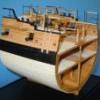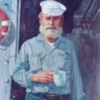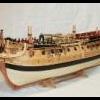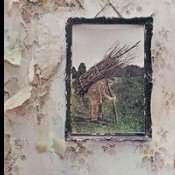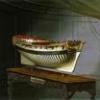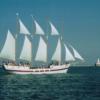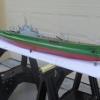Supplies of the Ship Modeler's Handbook are running out. Get your copy NOW before they are gone! Click on photo to order.
×
-
Posts
2,420 -
Joined
-
Last visited
Reputation Activity
-
 dvm27 reacted to michael mott in Bristol Pilot Cutter by michael mott - 1/8 scale - POF
dvm27 reacted to michael mott in Bristol Pilot Cutter by michael mott - 1/8 scale - POF
Had a nice visit with Jeff (Chasseur) last evening when he stopped by to see the Albertic.
More reworking of the companionway. I am reworking the area that opens up to the hull. The opportunity to rework the position of the skylight which was a bit too close to the mast will be able to be sorted as well. I am going to widen the companionway to scale 36" (4.5"actual) so that it aligns with the skylight similar to the one on the Polly Agatha. So just to save mahogany I made a prototype out of some cardstock.
I will make a new deck piece by laminating the deck fir planks over the 1/8th aircraft ply sheet once it is properly curved and the cut outs for the companionway and skylights are done.
I actually spent a good part of the day working on upgrading the drawing that I first made when this project began way back in 2012. so a lot of measuring and fixing the drawing which was rudimentary at best.
Michael
-
 dvm27 got a reaction from jml1083 in Medway Longboat 1742 by Chuck - FINISHED - 1/2" scale
dvm27 got a reaction from jml1083 in Medway Longboat 1742 by Chuck - FINISHED - 1/2" scale
Chuck's incredible modeling skills aside, his wood choice does have a very pleasing scale appearance when viewed close up. Looks a lot like full scale pine to me. Certainly more realistic than boxwood in my opinion. I've been working on a project using the yellow cedar for the first time and had trouble achieving a finish similar to Chucks. He recommended using much finer sandpaper 280 - 400 grit and the results are much better.
-
 dvm27 got a reaction from Rustyj in Medway Longboat 1742 by Chuck - FINISHED - 1/2" scale
dvm27 got a reaction from Rustyj in Medway Longboat 1742 by Chuck - FINISHED - 1/2" scale
Chuck's incredible modeling skills aside, his wood choice does have a very pleasing scale appearance when viewed close up. Looks a lot like full scale pine to me. Certainly more realistic than boxwood in my opinion. I've been working on a project using the yellow cedar for the first time and had trouble achieving a finish similar to Chucks. He recommended using much finer sandpaper 280 - 400 grit and the results are much better.
-
 dvm27 got a reaction from JeffT in Medway Longboat 1742 by Chuck - FINISHED - 1/2" scale
dvm27 got a reaction from JeffT in Medway Longboat 1742 by Chuck - FINISHED - 1/2" scale
Chuck's incredible modeling skills aside, his wood choice does have a very pleasing scale appearance when viewed close up. Looks a lot like full scale pine to me. Certainly more realistic than boxwood in my opinion. I've been working on a project using the yellow cedar for the first time and had trouble achieving a finish similar to Chucks. He recommended using much finer sandpaper 280 - 400 grit and the results are much better.
-
 dvm27 got a reaction from oneslim in Medway Longboat 1742 by Chuck - FINISHED - 1/2" scale
dvm27 got a reaction from oneslim in Medway Longboat 1742 by Chuck - FINISHED - 1/2" scale
Chuck's incredible modeling skills aside, his wood choice does have a very pleasing scale appearance when viewed close up. Looks a lot like full scale pine to me. Certainly more realistic than boxwood in my opinion. I've been working on a project using the yellow cedar for the first time and had trouble achieving a finish similar to Chucks. He recommended using much finer sandpaper 280 - 400 grit and the results are much better.
-
 dvm27 got a reaction from Seventynet in Using a moulding scraper tool?
dvm27 got a reaction from Seventynet in Using a moulding scraper tool?
I do have a complete set of those Micro Shapers and find the profiles too large for most of the moldings I need at 1:48 scale.
-
 dvm27 got a reaction from mtaylor in Medway Longboat 1742 by Chuck - FINISHED - 1/2" scale
dvm27 got a reaction from mtaylor in Medway Longboat 1742 by Chuck - FINISHED - 1/2" scale
Chuck's incredible modeling skills aside, his wood choice does have a very pleasing scale appearance when viewed close up. Looks a lot like full scale pine to me. Certainly more realistic than boxwood in my opinion. I've been working on a project using the yellow cedar for the first time and had trouble achieving a finish similar to Chucks. He recommended using much finer sandpaper 280 - 400 grit and the results are much better.
-
 dvm27 got a reaction from Canute in Medway Longboat 1742 by Chuck - FINISHED - 1/2" scale
dvm27 got a reaction from Canute in Medway Longboat 1742 by Chuck - FINISHED - 1/2" scale
Chuck's incredible modeling skills aside, his wood choice does have a very pleasing scale appearance when viewed close up. Looks a lot like full scale pine to me. Certainly more realistic than boxwood in my opinion. I've been working on a project using the yellow cedar for the first time and had trouble achieving a finish similar to Chucks. He recommended using much finer sandpaper 280 - 400 grit and the results are much better.
-
 dvm27 reacted to Kurt Johnson in Medway Longboat 1742 by Chuck - FINISHED - 1/2" scale
dvm27 reacted to Kurt Johnson in Medway Longboat 1742 by Chuck - FINISHED - 1/2" scale
Boy, that camera is your friend!! I’ve never seen a model look so clean and perfect. Not a smudge or scatch anywhere. Please tell me there’s a big pile of regects laying all over the floor. I don’t think a full sized boat would be able to look that fine.
Kurt
-
 dvm27 reacted to tlevine in HMS Atalanta 1775 by tlevine - FINISHED - 1:48 scale - from TFFM plans
dvm27 reacted to tlevine in HMS Atalanta 1775 by tlevine - FINISHED - 1:48 scale - from TFFM plans
I have spent the last few weeks constructing the lantern. I used the brass photoetch from Admiralty Models for the carcass. Rather than post a step-by-step construction, take a look on their website. http://www.admiraltymodels.com/Tips.html The document is at the bottom of the page. The exterior was painted to match the wood and the interior was painted red. The candle is a roll of paper and the glazing is mica. The crank is brass which was cut and filed to shape. All metal was blackened.
-
 dvm27 reacted to Chuck in Medway Longboat 1742 by Chuck - FINISHED - 1/2" scale
dvm27 reacted to Chuck in Medway Longboat 1742 by Chuck - FINISHED - 1/2" scale
Thanks Dirk,
Moving right along, the cap rail was added. It is made of 4 laser cut pieces. They are made over sized and we will thin them down considerably later.
A few things worth noting are the cut-away for the roller at the bow. This is on the port side only. So I had to remember to put it on the right side. A 50-50 shot of screwing that up.
Anyway, you will notice that I penciled in some reference lines to show everyone what this will eventually be shaped like. But this will happen gradually as we need to take this in steps. There are many details to be added which are easier with an over sized cap rail.
At the stern you will notice how the cap rail goes UNDER the wings of the transom. This is important to note as you are planking. There will be a gap between the plank and the transom and that is normal and as designed so the cap rail will fit. It is 1/16" thick.
The reason why we cant just start thinning down the cap rail as usual is because this longboat has an interesting feature at the bow we must complete first. Normally we would sand the cap rail flush with the outboard planking. But before we can do that, we have to fabricate the bolsters at the bow. There are two bolsters on each side of the stem. This "beefs" up the stem and helps support the area with the roller. In addition, it strengthens everything up there to help support the bowsprit iron and bowsprit.
You can kind of see the bolsters in this photo of the contemporary model.
Here is what ours will look like.
On every model that I make there are at least one or two parts that are quite a challenge to make. On this model, it will be these bolsters. There are many compound angles to consider. But if you plan it out ahead of time it will go smoothly. You will start with a laser cut blank. Because these parts have the potential for many attempts to end up in the trash....I will provide everyone with eight blanks so you will have plenty of fun.
But I will explain step by step how I shaped these bolsters and hopefully it will become clear.
First, I recommend starting with the starboard side which has no roller. The blanks are all the same so it doesnt matter which ones you choose. Below you can see that if you hold the blanks against the stem tightly that the aft edge will need to be beveled quite a bit so it sits flush against the hull planking. This is the first thing that you should do and dont worry about any gaps at the top too where the bolster sits under the cap rail. Just concentrate on the getting a snug tight fit against the planking first.
I have guestimated the amount of bevel required below by marking it in pencil for you guys. Note how there is more of a bevel towards the bottom of the bolster.
I used sand paper and files to create the bevel. I stopped and tested its fit dozens of times as I tweaked it. The photo below shows that its almost there. There is plenty of meat on these blanks so you can sand and reshape quite a bit. So just keep going until it fits good against the planking.
Once you are satisfied, You can do the same thing with the top edge and how it fits under the cap rail. It should also be a tight fit here. In the previous photo you can see it fits pretty good without any tweaking. But I will give it a few passes anyway.
Next you want to draw in the line that represents the concave shape of the bolster on its outside face. It will taper down to just 1/32" thick at the bottom. This line should follow the run of the sheer and planks. You should place the line even with the bottom of the first plank. I placed mine a bit low in the photo below...so adjust yours to be even with the plank line.
Once completed the two bolsters will look like this. And after you create the concave shape you can trim the bottom so it lines up with the bottom of the third plank. Its over-sized and will need to be trimmed. In addition, the front edge will eventually be sanded flush with the stem. But right now it hangs over quite a bit. That is OK. Just deal with shaping them and trimming the bottom edge right now.
Note how you will need to make a matching pair of these. The only difference is that a small notch needs to be carved out of the top of the one for the roller. You can see that below. It adds more room for the roller itself. Its shown on the left.
Glue them into position and then sand the front face of both flush with the stem. Thats all there is to it......easy-peasy right???
Dont worry its not too bad. JUst go slow and take your time. You will be able to adjust the shape a bit after its glued into position as well. This will make it easier to get a matching pair port and starboard. Dont sand the side of the cap rail yet!!!! Other than the front edge, leave it as is near the bolsters. We will be sanding other parts of the cap rail first.
-
 dvm27 reacted to Forlani daniel in Chebece 1750 by Forlani daniel - FINISHED - 1:48
dvm27 reacted to Forlani daniel in Chebece 1750 by Forlani daniel - FINISHED - 1:48
Ciao a tutti, continua il lavoro per realizzare le numerose coste....
Hello everyone, continue the work to realize the many coasts….
Un Saluto
-
 dvm27 reacted to bobcat in Seawatch Books
dvm27 reacted to bobcat in Seawatch Books
Soon, patience, soon. Book two will be on third rates.
Bob Friedman
-
 dvm27 reacted to RafaelP in Syren Rope Rocket
dvm27 reacted to RafaelP in Syren Rope Rocket
Here are my rope samples using the Rope Rocket so far using some few different threads,
From left to right;
1. Londonderry Linen size 4, 3-strand, final size 1.3mm.
Starting thread was fuzzy. I used extra beeswax, and burned off some of the fuzz(which is why it looks a little sooty!)
2. Corel kit supplied thread(it looks like linen, .4mm) 3-strand, final size 1.1mm
I like to look and feel of this one.
3. Londonderry linen #3095, 30/3, 3-strand, final size .85
Fuzzy and lumpy, disappointedin this thread.
3-6. Rope Rocket supplied thread; DMC Cordonnet Specia(cotton), no. 40, ecru, final sizes 1.3mm, 1mm, 65mm.
This thread makes really sharp rope!
7. Gutterman Quilting thread(cotton,) CA 02776, 3-strand, final size .5mm
I like the color, gloss and smoothness
-
 dvm27 reacted to Mark Pearse in 28' Ranger-type Yacht by Mark Pearse - FINISHED - 1:12
dvm27 reacted to Mark Pearse in 28' Ranger-type Yacht by Mark Pearse - FINISHED - 1:12
thanks all,
having the spars made I wasn't really confident that they looked right, I had difficulty seeing if the sizes looked about right or not, so I made some paper sails. It was a lot of fun & it also confirmed that the sail & spar sizes are quite good. To my eye the sails look just slightly conservative in area, but I would prefer that than if they looked a little oversized - this boats look chunky but I believe it would be lightly built & lightly ballasted. The headsail is intended to be a #2 & is still a little too large, probably move the clew forwards by 15 or 20mm & up about 10mm.
I'm starting to think whether it's better for the sails to be set to appear as if they have wind, or just hang.....
I'll post some photos of the rigging details shortly,
Mark
-
 dvm27 got a reaction from Elijah in Medway Longboat 1742 by Chuck - FINISHED - 1/2" scale
dvm27 got a reaction from Elijah in Medway Longboat 1742 by Chuck - FINISHED - 1/2" scale
Great planking tutorial, Chuck. Of course, you could transfer those faired tick marks from your hull to the edge of the laser cut frames for the production run. One might introduce slight variations while raising the frames but overall it would be easy to adjust the spiled planks to these reference marks. But then you are providing the fish instead of teaching how to fish.
-
 dvm27 reacted to Chuck in Medway Longboat 1742 by Chuck - FINISHED - 1/2" scale
dvm27 reacted to Chuck in Medway Longboat 1742 by Chuck - FINISHED - 1/2" scale
Thank you so much guys. It was time for the fun part.....to remove the buildboard and break away the frame centers.
The first step was to remove the braces for the stem and stern post. At the stern post I just pushed them free from the bottom. Then I shook them out.
After I removed the tape holding both halves of the buildboard together, I carefully and gently coaxed one half of the buildboard free. Dont rush this and slowly pry it off a little at a time working one side then the other. It will be tricky to get it started especially on a humid day. But once it starts wiggling free it will come off readily.
Then using your special tool of choice (everyone has their favorite) you can carefully and slowly cut through the tabs on each side of the frame centers. Then bend them back and forth to snap them out. Do this one at a time. Dont worry about breaking any frames because that will not happen if you have glued the top of your frames securely to the sheer plank. If when you start cutting the tab you see that the entire frame is loose and not secured to the sheer plank, stop and apply some CA. Let it "wick" down to glue the frame to the plank. Then resume cutting that tab.
I used the thin saw on the left this time but often use a simple file as well. Whatever you are comfortable with.
Here is a shot of a frame center on the barge being removed as I didnt take any of the longboat. Same principle. So I didnt want to duplicate in order save some time.
And finally some pictures of the model after removing all of the frame centers.
The next step will be fine tuning the sheer. I will sand the tops of the frames flat to the sheer and also sand the sheer so it has a good smooth run. I dont want any dips or high spots. These can be seen by viewing the hull head-on and stern -on at various angles. Once satisfied I will add the caprail which is laser cut. Hopefully over the next day or so. 😊
-
 dvm27 reacted to archjofo in La Créole 1827 by archjofo - Scale 1/48 - French corvette
dvm27 reacted to archjofo in La Créole 1827 by archjofo - Scale 1/48 - French corvette
Hello,
thanks for the positive comments and the others for the LIKES.
The buoys for the anchors are made.
Here is a picture with all buoys.
-
 dvm27 reacted to marsalv in Pandora by marsalv - FINISHED - 1:52
dvm27 reacted to marsalv in Pandora by marsalv - FINISHED - 1:52
So finally, after about 3750 hours, I got to the finish.
Thanks to everyone for watching my log and I would like to invite you to watch my next building log - Le Gros Ventre POF.
-
 dvm27 reacted to Chuck in Medway Longboat 1742 by Chuck - FINISHED - 1/2" scale
dvm27 reacted to Chuck in Medway Longboat 1742 by Chuck - FINISHED - 1/2" scale
I dont clamp my planks. Clamps arent needed ever....it just complicates things and makes it more difficult. At least for me.
If you shape your planks properly and pre bend them they should not need any clamps. I take my time tweaking, bending and twisting ahead of time. I will test each and every plank over and over again before I ever glue it into position. Its not something that happens immediately after spiling a plank. Even after having a laser cut plank already shaped, it is close to fitting well..... but never perfect. There may be gaps and high spots because of how I placed the previous plank on the hull. Its an inexact process. There may be slight gaps between it and the previous strake. So I use sandpaper and sanding sticks to bevel a bit more.....or very lightly remove a high spot that might prevent an area next to it from fitting tightly. I will remove just a hair and then retest. I will do this until the plank fits snug against the previous strake all along its length. I may also re bend or re-twist using heat. Then test some more. I could easily spend 45 minutes to an hour on one plank if its giving issues. I may over bevel or over twist and end up screwing it up. So I toss it and make another.
For all of my builds I use Titebond exclusively....except for planking. All of my planking is held to the frames with CA. I add a drop or two of CA with a toothpick to just two or three frames being careful to be very neat. Then I glue the plank to those few frames. Then I flex the plank so I can add some more CA to the next two frames...lifting it slightly to reach under it with my toothpick glue applicator....position and press the plank against those frames. I will slowly work my way down the length of the plank a few frames at a time making sure it tightly fits against the previous strake. I just hold it with my fingers for a few seconds and press it flat against the frames. The glue will hold and no forcing is needed, because the shape was good and the twist and bend was good before I started gluing.
Hope that makes sense. At times when I have to sand a high spot off the edge of a plank so it fits tightly against the plank already on the hull, I will have to make a mental note to adjust the next strake so I can stay faithful to my tick marks and planking plan that I made while lining out. This is what prevents the run of the planking from getting too waavy or out of wack. Without those tick marks as a guide I would be lost, with or without pre spiled and laser cut planks.
I hope this rather lengthy description makes sense. But this is basically my process. No magic just slow and methodical, No special clamping procedure other than my fingers. test ....shape .....then retest....and finally glue. Its hard to describe in writing.
One thing I will mention however. I have been watching a lot of people plank hulls over the years. In most cases the planks they are using are way too thick. The thicker the plank the harder it is to glue it into position. I rarely use planking thicker than 3/64" thick. If I need a thicker plank like in this case....I would rather use two layers than try to bend and twist a 1/16" thick strip or a 5/64" thick strip. That is just nuts. I have watched some people try and bend really thick planks for the wales...why in the world does this make sense when after using several layers nobody can ever tell the difference. Like on those Hahn models you are building. I am amazed at the thickness of the wales and you guys try to force one big thick chunk of wood into position with or without pre-bending and twisting. Its something I will never understand.
-
 dvm27 got a reaction from bhermann in Young America 1853 by EdT - FINISHED - extreme clipper
dvm27 got a reaction from bhermann in Young America 1853 by EdT - FINISHED - extreme clipper
You mean you guys don't have the famous Rig Wright? It converts circumference to diameter and scale diameter in four different scales by rotating the dial.
-
 dvm27 got a reaction from Piet in Young America 1853 by EdT - FINISHED - extreme clipper
dvm27 got a reaction from Piet in Young America 1853 by EdT - FINISHED - extreme clipper
You mean you guys don't have the famous Rig Wright? It converts circumference to diameter and scale diameter in four different scales by rotating the dial.
-
 dvm27 reacted to Chuck in Medway Longboat 1742 by Chuck - FINISHED - 1/2" scale
dvm27 reacted to Chuck in Medway Longboat 1742 by Chuck - FINISHED - 1/2" scale
Today was a lazy, hot summer day. I am pretty caught up making rope and blocks so I decided to spend the day finishing the external planking.
The last two strakes along the sheer were completed. As mentioned earlier, these are thicker planks than those below them. The second strake being the wales. I contemplated doing these two last strakes several ways. One I thought about was to just use thicker planks. This is a good solution but I kept thinking about some of the guys I know who have trouble bending and twisting heavier planks. The hull is pretty sturdy at this point but being forceful with a heavy plank could be problematic for some, especially if they dont take the time to properly pre-bend and twist it to shape.
So in the end I opted for a modelers convention of simplification. Just as I add the wales on my other builds, I decided to use two layers. The 1/32" thick planks bend and twist very easily. This is especially true with the yellow cedar. A second layer of 1/32" planking will be laid right on top of the last two strakes and nobody will be the wiser.
Here is the hull with the first layer of planking completed. I was quite happy with the results. Once both sides were done I could see that the port side was less than 1/64" lower at mid ship than the starboard. Nothing that cant be adjusted with the second layer. This is one of the benefits of using a second layer. You can make small adjustments to correct any issues with the ring of your planking at the shear.
The second layer is also 1/32" thick. But this is actually slightly thicker than I would like. It is better to sand them down slightly afterwards so they are a bit thinner and not standing so proud of the planks below it.
On addition note. At the bow and stern, the planks are actually not thicker. They should gradually reduce in thickness so they are the flush with the planking below them. This is easy enough to do after both strakes are completed. At the stern, I just sanded the last 1/2" of planking so it gradually reduced in thickness and matched the other strakes when viewing the transom head on. You can see this feature on the contemporary model attached. You can also see where I shifted one layer to correct the run. This wont be seen under the painted frieze.
The same thing was done at the bow, but I find it easier to use a sharp chisel to slice away the thicker plans along the stem to reduce their thickness. Then I feather that back with some sandpaper so its gradual as it should be. This is all very similar to clinker planking on the barge but we are cheating perhaps and using two layers to simulate the same look.
Heres the contemporary model...which is simalar because it was carved and hollowed out from a solid piece of boxwood. The wales and sheer strake were then added as a layer on top of the solid carved hull. Can you imagine basically hollowing out a block until it was thin as an eggshell!!!
And one last photo of my hull. All the exterior planking is now complete. I could leave it on the baseboard.....so I could nail the planks (not treenail because they were actual nails). BUT I think it will be easier to do after the cap rail is in position. I also find it hard to see the frames down by the keel now and I dont know where to place my nails. Removing the frame centers and the hull from the baseboard will allow me to hold it up to the light and see the frames clearly. The planks are so thin it is quite easy to do. I will hopefully mark the locations of the frames this way so I dont miss when I drill the holes for the little nails. Hope that makes sense. So tomorrow I will remove it from the baseboard and break-out the frame centers. I have already removed the braces at the bow and the stern that helped hold them stationary. They weren't glued into the slots, so I just popped them out. Even the two center ones at the stern. It will make removing the baseboard easier.
-
 dvm27 got a reaction from mtaylor in Young America 1853 by EdT - FINISHED - extreme clipper
dvm27 got a reaction from mtaylor in Young America 1853 by EdT - FINISHED - extreme clipper
You mean you guys don't have the famous Rig Wright? It converts circumference to diameter and scale diameter in four different scales by rotating the dial.
-
 dvm27 got a reaction from Richvee in Young America 1853 by EdT - FINISHED - extreme clipper
dvm27 got a reaction from Richvee in Young America 1853 by EdT - FINISHED - extreme clipper
You mean you guys don't have the famous Rig Wright? It converts circumference to diameter and scale diameter in four different scales by rotating the dial.


